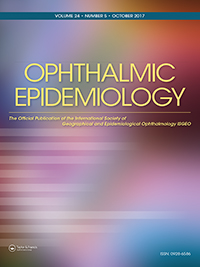The Distribution of Macular Thickness and Its Determinants in a Healthy Population
Authors
Affiliations
1a Noor Research Center for Ophthalmic Epidemiology, Noor Eye Hospital , Tehran , Iran.
2b Noor Ophthalmology Research Center, Noor Eye Hospital , Tehran , Iran.
3c Department of Medical Surgical Nursing, School of Nursing and Midwifery , Shahid Beheshti University of Medical Sciences , Tehran , Iran.
4d Department of Optometry, School of Paramedical Sciences , Mashhad University of Medical Sciences , Mashhad , Iran.
5e Center for Health Related Social and Behavioral Sciences Research , Shahroud University of Medical Sciences , Shahroud , Iran.
6f Department of Epidemiology and Biostatistics, School of Public Health , Tehran University of Medical Sciences , Tehran , Iran.
Abstract
Purpose: To determine the distribution of macular thickness in a healthy Iranian population aged 45-69 years and its association with certain determinants.
Methods: All participants underwent optometric examinations including measurement of uncorrected and corrected visual acuity, objective refraction by retinoscopy, and subjective refraction. Subsequently, all participants underwent slit-lamp biomicroscopy followed by fundus examination through direct and indirect ophthalmoscopy, and optical coherence tomography (OCT) imaging under pupil dilation.
Results: Mean central macular thickness was 255.4 µm (95% confidence interval, CI, 254.5-256.3 µm), average inner macular thickness was 316.5 µm (95% CI 315.9-317.1 µm), average outer macular thickness was 275.3 µm (95% CI 274.8-275.8 µm), and overall average thickness was 278.6 µm (95% CI 278.1-279.1 µm). A linear multiple regression model showed that all indexes were significantly larger in male participants (p < 0.001). Central macular thickness increased with age (coef = 0.25, p < 0.001) while overall, inner and outer macular thickness decreased with age (coef = -0.18, -0.15, -0.19, respectively, all p < 0.001). Central and inner macular thickness had a positive correlation (coef = 3.8, 2.6, respectively, both p < 0.001) and outer macular thickness had a negative correlation (coef = -1.6, p < 0.001) with axial length.
Conclusion: Age, sex, refractive error, axial length, and keratometry were found to be associated with macular thickness. These factors should be taken into account when interpreting macular thickness measurements with spectral-domain OCT.
Keywords: Adult; macular thickness; ocular biometry; population-based study; refractive errors.

